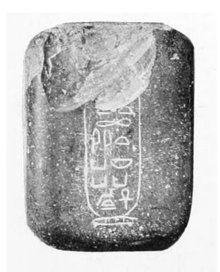Nebkaure Khety was an ancient Egyptian pharaoh of the 9th or 10th Dynasty, during the First Intermediate Period.
| Nebkaure Khety | ||||||||||||||||||||||||||||||||||||||||||||||
|---|---|---|---|---|---|---|---|---|---|---|---|---|---|---|---|---|---|---|---|---|---|---|---|---|---|---|---|---|---|---|---|---|---|---|---|---|---|---|---|---|---|---|---|---|---|---|
| Kheti, Akhtoy, Achtoi | ||||||||||||||||||||||||||||||||||||||||||||||
 | ||||||||||||||||||||||||||||||||||||||||||||||
| Pharaoh | ||||||||||||||||||||||||||||||||||||||||||||||
| Reign | between 2160 and 2130 BCE[1] | |||||||||||||||||||||||||||||||||||||||||||||
| Predecessor | Neferkare VII | |||||||||||||||||||||||||||||||||||||||||||||
| Successor | Setut | |||||||||||||||||||||||||||||||||||||||||||||
| ||||||||||||||||||||||||||||||||||||||||||||||
| Dynasty | 9th Dynasty | |||||||||||||||||||||||||||||||||||||||||||||
Reign
editPractically nothing is known about the events of Nebkaure's reign; due to the contrasting opinions of scholars, even its dating is still difficult. Many Egyptologists assign Nebkaure to the 9th Dynasty, possibly the fourth king (and the second king bearing the name Khety), just after Neferkare.[2][3][4] On the other hand, other scholars such as Jürgen von Beckerath believe instead that Nebkaure reigned during the subsequent 10th Dynasty, possibly before Meryibre Khety.[5]
Attestations
editLike many of the kings who preceded or succeeded him, attestations of Nebkaure Khety are scant.
Red Jasper Weight
editThe only contemporary object bearing his cartouche is a weight made from red jasper which was unearthed by Flinders Petrie at Tell el-Retabah, a location along the Wadi Tumilat in the eastern Delta; this weight is now exhibited at the Petrie Museum (UC11782).[6][7] Weight was slightly damaged, Petrie gives its weight as 1,850 of his grain unit. Divided by 9 units on the stone, it gives a value that must have been about 205 grains, i.e. around 15 grams, which represents gold deben.
The Story about the Eloquent Peasant
editThe name of a king Nebkaure also appears on a late Middle Kingdom papyrus (Berlin 3023[5]) containing part of the well known and popular story The Eloquent Peasant; it is very likely that the king Nebkaure who enjoyed the peasant's magniloquence so much was Nebkaure Khety indeed.[2][4][7]
Non-contemporary attestations
editOn the Turin King List he was tentatively placed in the register 4.21.
References
edit- ^ William C. Hayes, in The Cambridge Ancient History, vol 1, part 2, 1971 (2008), Cambridge University Press, ISBN 0-521-077915, p. 996.
- ^ a b William C. Hayes, in The Cambridge Ancient History, vol 1, part 2, 1971 (2008), Cambridge University Press, ISBN 0-521-077915, p. 465.
- ^ Nicolas Grimal, A History of Ancient Egypt, Oxford, Blackwell Books, 1992, p. 140.
- ^ a b Michael Rice, Who is who in Ancient Egypt, 1999 (2004), Routledge, London, ISBN 0-203-44328-4, pp. 5-6.
- ^ a b Jürgen von Beckerath, Handbuch der Ägyptischen Königsnamen, 2nd edition, Mainz, 1999, p. 74.
- ^ Nebkaure's weight UC11782 in the Petrie Museum
- ^ a b Alan Gardiner, Egypt of the Pharaohs. An introduction, Oxford University Press, 1961, p. 112.